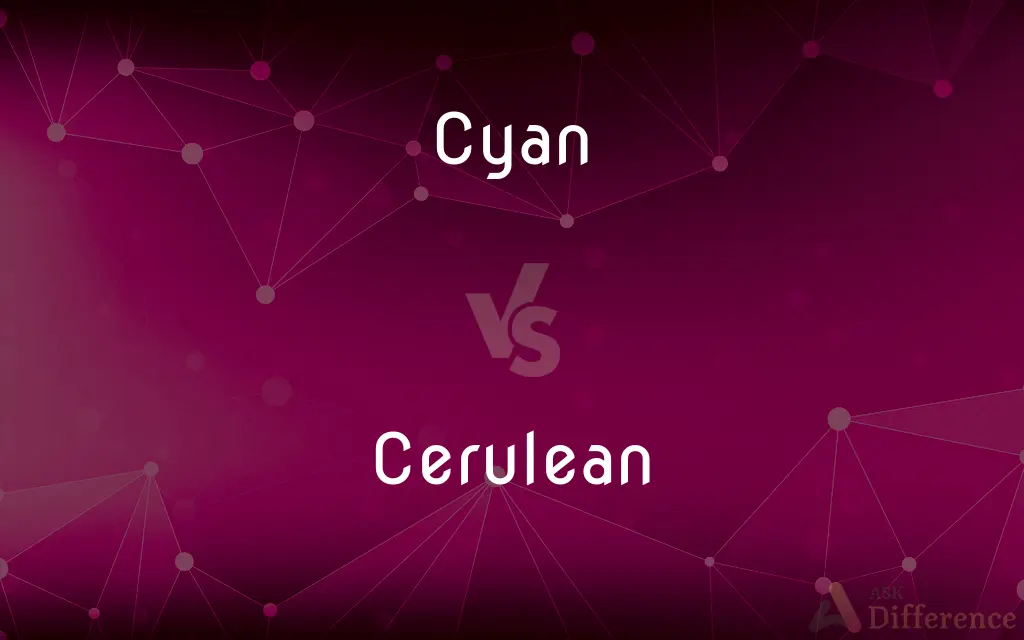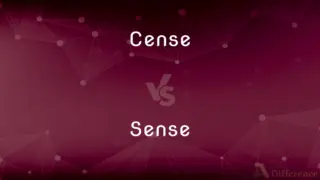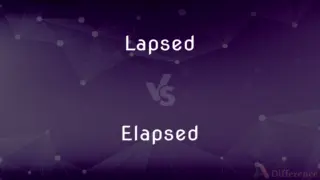Cyan vs. Cerulean — What's the Difference?
By Fiza Rafique & Urooj Arif — Updated on March 8, 2024
Cyan is a greenish-blue color, one of the primary colors in the subtractive color system, often used in color printing, while cerulean is a deep sky blue color, leaning more towards blue than green, and is associated with clear skies.

Difference Between Cyan and Cerulean
Table of Contents
ADVERTISEMENT
Key Differences
Cyan is recognized as a primary color in the subtractive (CMYK) color model, pivotal in color printing and photography. It's a bright, greenish-blue hue that plays a crucial role in mixing and producing a wide range of colors when combined with magenta and yellow. On the other hand, cerulean, which debuted as a pigment in the 19th century, is a deep, serene shade of sky blue with less green compared to cyan. It's often used in artistic painting and fashion for its calming and clear sky resemblance.
The visibility and application of cyan are most prominent in digital and print media, where it's utilized alongside magenta, yellow, and black to create full-color images. Its vibrant, greenish-blue appearance is a cornerstone for color blending in various technologies. Cerulean, with its soothing and deep sky blue character, is favored in interior design, fashion, and painting for its depth and calming effect, reminiscent of a clear, unclouded sky.
Cyan's significance extends into digital arts and imaging technologies, where understanding its role in color theory and printing is essential for professionals. It's a fundamental color for ink cartridges in printers, demonstrating its importance in producing accurate and diverse print colors. Cerulean, celebrated for its aesthetic appeal, finds its place in paint selections and design elements, highlighting its influence on style and visual art.
Despite both being shades of blue, the psychological impact and symbolism of cyan and cerulean diverge. Cyan is often associated with freshness, vitality, and communication, mirroring the vibrancy of tropical waters. Cerulean evokes feelings of tranquility and peace, inspired by its association with clear blue skies, making it a popular choice in spaces intended for relaxation and reflection.
In the realm of pigments and dyes, cyan is a basic, synthetic color used widely in printing inks, whereas cerulean is a specific pigment, initially made with cobalt stannate, offering artists and designers a distinct, rich hue. This distinction underscores the practical differences in their use: cyan in color processes and print media, and cerulean in artistic and decorative applications.
ADVERTISEMENT
Comparison Chart
Color Model
Subtractive (CMYK)
Not specific to a model; pigment-based
Hue
Greenish-blue
Deep sky blue
Primary Use
Color printing, digital art
Painting, fashion, interior design
Symbolism
Freshness, vitality
Tranquility, peace
Composition
Synthetic primary color
Cobalt stannate (historically)
Visibility in Media
Prominent in print and digital media
Favored in artistic and decorative contexts
Psychological Impact
Conveys communication, freshness
Evokes calmness, reminiscent of clear skies
Compare with Definitions
Cyan
A bright, greenish-blue hue that's vibrant and lively.
The graphic designer chose a cyan background to add vitality to the advertisement.
Cerulean
A deep, sky blue color, used as a pigment in painting and fashion.
The artist used cerulean to capture the sky's tranquil hue in her painting.
Cyan
Essential for digital arts and imaging technologies.
Mastering the use of cyan is crucial for accurate color reproduction in digital prints.
Cerulean
Favored for its aesthetic appeal in visual arts.
The dress's cerulean shade made it a standout piece in the spring collection.
Cyan
Utilized in ink cartridges for printers.
Replacing the cyan ink cartridge is necessary for continuing color printing tasks.
Cerulean
Popular in design for its tranquility.
Cerulean tiles were chosen for the spa to evoke a sense of peace and serenity.
Cyan
A primary color in the CMYK color model used in color printing.
The printer uses cyan ink alongside magenta and yellow to produce a wide range of colors.
Cerulean
Associated with calmness and peace, inspired by clear skies.
The interior designer recommended cerulean accents for a soothing bedroom ambiance.
Cyan
Symbolizes freshness and communication.
The company's logo was cyan to represent openness and innovation.
Cerulean
Made historically with cobalt stannate.
Cerulean pigment was prized for its vibrant, stable color in 19th-century paintings.
Cyan
Cyan () is the color between green and blue on the visible spectrum of light. It is evoked by light with a predominant wavelength between 490 and 520 nm, between the wavelengths of green and blue.In the subtractive color system, or CMYK color model, which can be overlaid to produce all colors in paint and color printing, cyan is one of the primary colors, along with magenta and yellow.
Cerulean
Cerulean (), also spelled caerulean, is a shade of blue ranging between azure and a darker sky blue. The first recorded use of cerulean as a colour name in English was in 1590.
Cyan
A greenish-blue colour which is one of the primary subtractive colours, complementary to red.
Cerulean
Azure; sky-blue.
Cyan
A greenish blue, one of the subtractive primary colors.
Cerulean
A greenish-blue color.
Cyan
A vibrant pale greenish-blue colour between blue and green in the visible spectrum; the complementary colour of red; the colour obtained by subtracting red from white light.
Cerulean
(countable) Any of various lycaenid butterflies of the genus Jamides.
Cyan
Of the colour cyan.
Cerulean
Sky-blue.
Cyan
A blue-green that is one of the primary pigments
Cerulean
Sky-colored; blue; azure.
Blue, blue, as if that sky let fall
A flower from its cerulean wall.
Cyan
A bluish shade of green
Cerulean
A light shade of blue
Cerulean
Of a deep somewhat purplish blue color similar to that of a clear October sky;
October's bright blue weather
Common Curiosities
What symbolism is associated with cyan?
Cyan symbolizes freshness, vitality, and communication, reflecting its lively and vibrant nature.
What is cyan?
Cyan is a primary color in the subtractive color model, characterized by a bright, greenish-blue hue.
What is cerulean?
Cerulean is a deep, sky blue color, often associated with the calmness and tranquility of a clear sky.
What emotions does cerulean evoke?
Cerulean evokes feelings of tranquility and peace, reminiscent of the serene and unclouded sky.
Does the psychological impact of a color affect its use in design?
Yes, the psychological impact and symbolism of colors like cyan and cerulean significantly influence their use in design and marketing.
How do cyan and cerulean differ in use?
Cyan is widely used in color printing and digital arts, while cerulean is favored in painting, fashion, and interior design.
Can cyan and cerulean be used interchangeably?
While both are shades of blue, their specific hues and contexts of use differ significantly, making them not directly interchangeable.
What makes cerulean distinct from other blues?
Cerulean is distinguished by its deep, sky blue color and its historical composition from cobalt stannate, offering a unique hue.
Why is cyan important in color printing?
Cyan is a fundamental color in the CMYK color model, essential for creating a wide spectrum of colors in print media.
Is cerulean a natural pigment?
Historically, cerulean was made using cobalt stannate, making it a synthetic but historically significant pigment.
How do artists choose between cyan and cerulean for their work?
Artists choose based on the desired emotional effect, with cyan offering vibrancy and vitality and cerulean evoking calmness and tranquility.
How does the visibility of cyan in media compare to cerulean?
Cyan is prominent in print and digital media due to its role in color processing, whereas cerulean is more favored in artistic and decorative contexts for its aesthetic appeal.
What industries use cerulean extensively?
The fashion, interior design, and painting industries use cerulean extensively for its tranquil and appealing hue.
Share Your Discovery

Previous Comparison
Cense vs. Sense
Next Comparison
Lapsed vs. ElapsedAuthor Spotlight
Written by
Fiza RafiqueFiza Rafique is a skilled content writer at AskDifference.com, where she meticulously refines and enhances written pieces. Drawing from her vast editorial expertise, Fiza ensures clarity, accuracy, and precision in every article. Passionate about language, she continually seeks to elevate the quality of content for readers worldwide.
Co-written by
Urooj ArifUrooj is a skilled content writer at Ask Difference, known for her exceptional ability to simplify complex topics into engaging and informative content. With a passion for research and a flair for clear, concise writing, she consistently delivers articles that resonate with our diverse audience.














































